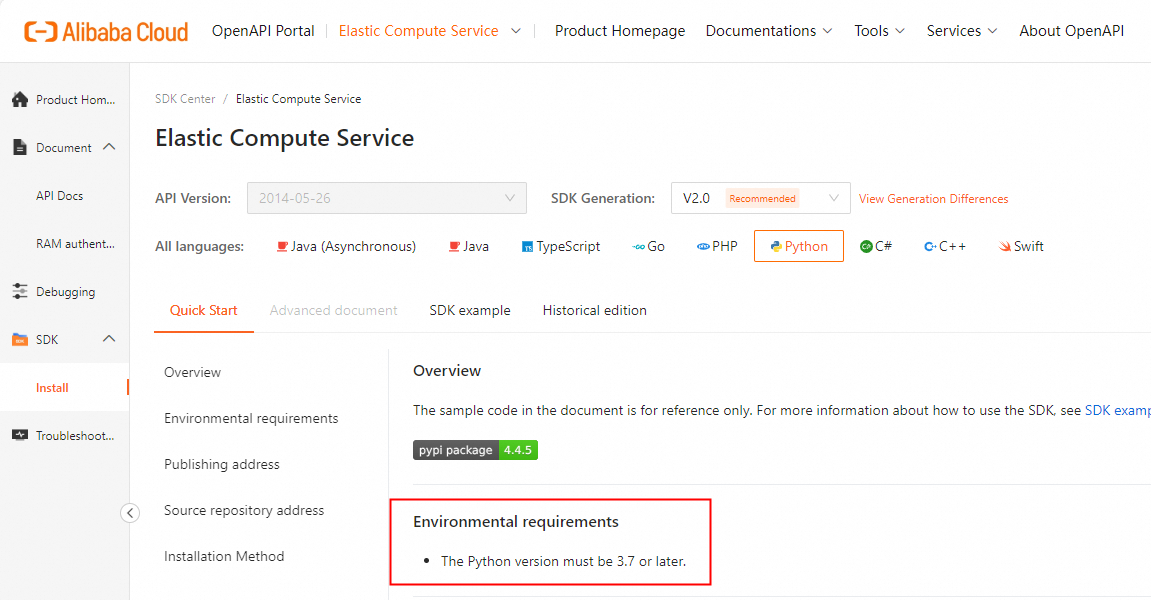This topic describes common installation issues of Alibaba Cloud SDK for Python on a Linux Elastic Compute Service (ECS) instance and provides corresponding solutions.
Issues
FAQs and solutions
Issue 1: How do I check the minimum Python version required for using Alibaba Cloud SDK for Python?
The minimum Python version required for using Alibaba Cloud SDK for Python is based on the end-of-life dates for all Python versions that Python Software Foundation (PSF) publishes. Visit the OpenAPI portal to verify the specific version requirements for Python.
Issue 2: Error message "Command "python setup.py egg_info" failed with error code 1 in XX" is displayed when I install the SDK.
This error arises from an outdated Python or pip version, or the absence of required dependencies. To resolve this issue, apply the following methods:
Verify the Python version.
Check that your Python version satisfies the requirements of Alibaba Cloud SDK for Python by running
python -Vorpython3 -Von your ECS instance. If the version is incompatible, install the latest Python version. For information about Python installation guidance, see Issue 4: How do I install Python3?Update pip if the Python version is compatible.
Using the most recent pip version can prevent certain common issues. Update pip with
pip install --upgrade pipand try to install the SDK again.
Issue 3: Error message "ModuleNotFoundError: No module named 'XX'" is displayed when I install the SDK.
This error indicates missing dependency libraries. Resolve it by running the pip install XX command.
Issue 4: How do I install Python3?
To install Python3 on CentOS, follow the steps below. For more information about Python3 installation methods, see Install Python on Linux.
Obtain the latest Python source package from the official Python website. Run the following commands to download and extract it. In this example, Python 3.11.10 is used.
wget https://www.python.org/ftp/python/3.11.10/Python-3.11.10.tgz tar -xzvf Python-3.11.10.tgzBefore compiling Python, ensure that you have installed the required dependency libraries and tools.
sudo yum -y install gcc sudo yum -y install zlib-devel bzip2-devel openssl-devel ncurses-devel sqlite-devel readline-devel tk-devel gdbm-devel libpcap-devel xz-devel libffi-develNavigate to the source directory to configure and compile Python.
cd Python-3.11.10 ./configure --prefix=/usr/python make && sudo make altinstallRun the
which python3 pip3command to verify the presence of symbolic links for python3 and pip3 in the current system. If these symbolic links exist, they must be removed.
sudo rm -rf /usr/bin/python3 /usr/bin/pip3Create new symbolic links for python3 and pip3 to the executable files.
NoteSymbolic links act as shortcuts to files or directories, enabling quick access. For example, running python3 actually runs the python 3.11 interpreter.
sudo ln -s /usr/python/bin/python3 /usr/bin/python3 sudo ln -s /usr/python/bin/pip3 /usr/bin/pip3Confirm the installed Python version.
python3 -V pip3 -V
Issue 5: How to upgrade Python2 to Python3?
Install the desired version of Python 3.XX.XX on your ECS instance. Once installed, Python3 commands will be available for use. For detailed installation instructions, refer to Issue 4: How to install Python3.